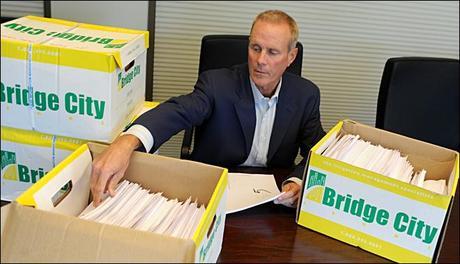
Attorney Kelly Clark reviews
the Boy Scouts "perversion files"
Yesterday's release of the Boy Scouts' "perversion files" reveals that the organization systematically covered up child sexual abuse for more than 25 years. That probably is the most shocking part of the story for the general public. But it is not a surprise to us.
We have been reporting for months on child abuse involving Ted Rollins, CEO of Charlotte-based Campus Crest Communities. We have shown that Rollins was convicted for a 1995 assault on his 16-year-old stepson in Franklin County, North Carolina. We have shown that Rollins was investigated in 1993, based on a citizen complaint to North Carolina Social Services, for possible sexual abuse of the same stepson.
In both instances, the serious nature of Rollins' actions was covered up. In recent weeks, we've learned that powerful forces on Wall Street are trying to cover up for Rollins to this day. Campus Crest Communities completed a $380-million IPO in late 2010, and we will show in a series of upcoming posts that investment insiders are turning a blind eye to Rollins' ugly past.
We are talking about a diseased corporate culture, one that values secrecy over the well-being of children. A similar culture clearly infested the Boy Scouts. Reports CBS News:
Again and again, decade after decade, an array of authorities — police chiefs, prosecutors, pastors and local Boy Scout leaders among them — quietly shielded scoutmasters and others accused of molesting children, a newly opened trove of confidential papers shows.
At the time, those authorities justified their actions as necessary to protect the good name and good works of Scouting, a pillar of 20th century America. But as detailed in 14,500 pages of secret "perversion files" released Thursday by order of the Oregon Supreme Court, their maneuvers allowed sexual predators to go free while victims suffered in silence.
Files released yesterday covered 1959 to 1985, and they show over and over that cover ups took place across the country. How could that happen? CBS News provides insight:
In 1972, a local Scouting executive beseeched national headquarters to drop the case against a suspected abuser because he was undergoing professional treatment and was personally taking steps to solve his problem. "If it don't stink, don't stir it," the local executive wrote. . . .
But one of the most startling revelations to come from the files is the frequency with which attempts to protect Scouts from molesters collapsed at the local level, at times in collusion with community leaders.
It happened when a local district attorney declined to prosecute two confessed offenders; when a three-judge panel included two men on the local Scouting executive board; when law enforcement sought to protect the name of Scouting and let an admitted child molester go free.
Such cover-ups are not limited to the world of Scouting. We've seen signs of them in the Ted Rollins story. During the 1993 sexual-abuse investigation, the family was referred to a psychologist at Duke University. Sherry Carroll Rollins stated in a solo session that a maid had been cleaning a closet when she discovered more than 100 towels, soiled with feces and the apparent by-products of anal sex. She also stated that her husband kept curious items--a spatula, bungee cord, and neckties--in a vehicle he used to drive the stepson to school.

Ted Rollins
Did the psychologist report this alarming information to authorities? Nope. He recommended that Ms. Rollins read a book called The Homosexual Matrix, so that she could better understand what likely was going on between her husband and son. Did it occur to the psychologist that maybe he needed to take steps that would put a stop to apparent abuse? We probably will never know.When Ted Rollins did face criminal charges in 1995, the case was treated as a "simple assault," even though the 16-year-old victim had a broken nose, a torn lip, and enough blood loss that he was treated for possible shock. Our research indicates Rollins should have been charged with "assault inflicting serious injury," which might have resulted in jail time. Instead, he got off with a modest fine.
Under North Carolina law, the assault should have been treated as a case of child abuse. Any number of professionals in law enforcement and health care were required to report the beating to social services for investigation. We've seen no sign in the public record that anyone did that.
The story of the Boy Scouts' "perversion files" is not likely to go away soon, reports The Daily Beast:
Victims’ advocates say the release of the documents could lead to a new spate of criminal prosecutions or civil lawsuits from newly emboldened victims. Seattle attorney Tim Kosmoff is among those calling for a congressional probe.
Such a probe, if it happens, should not be limited to Scouting. The Jerry Sandusky scandal at Penn State has shown us that evidence of child sexual abuse was treated lightly in higher education. We've come across similar treatment in our reporting on CEO Ted Rollins. In fact, we soon will show that a Wall Street official has taken extraordinary steps in an effort to sweep the story out of view.
